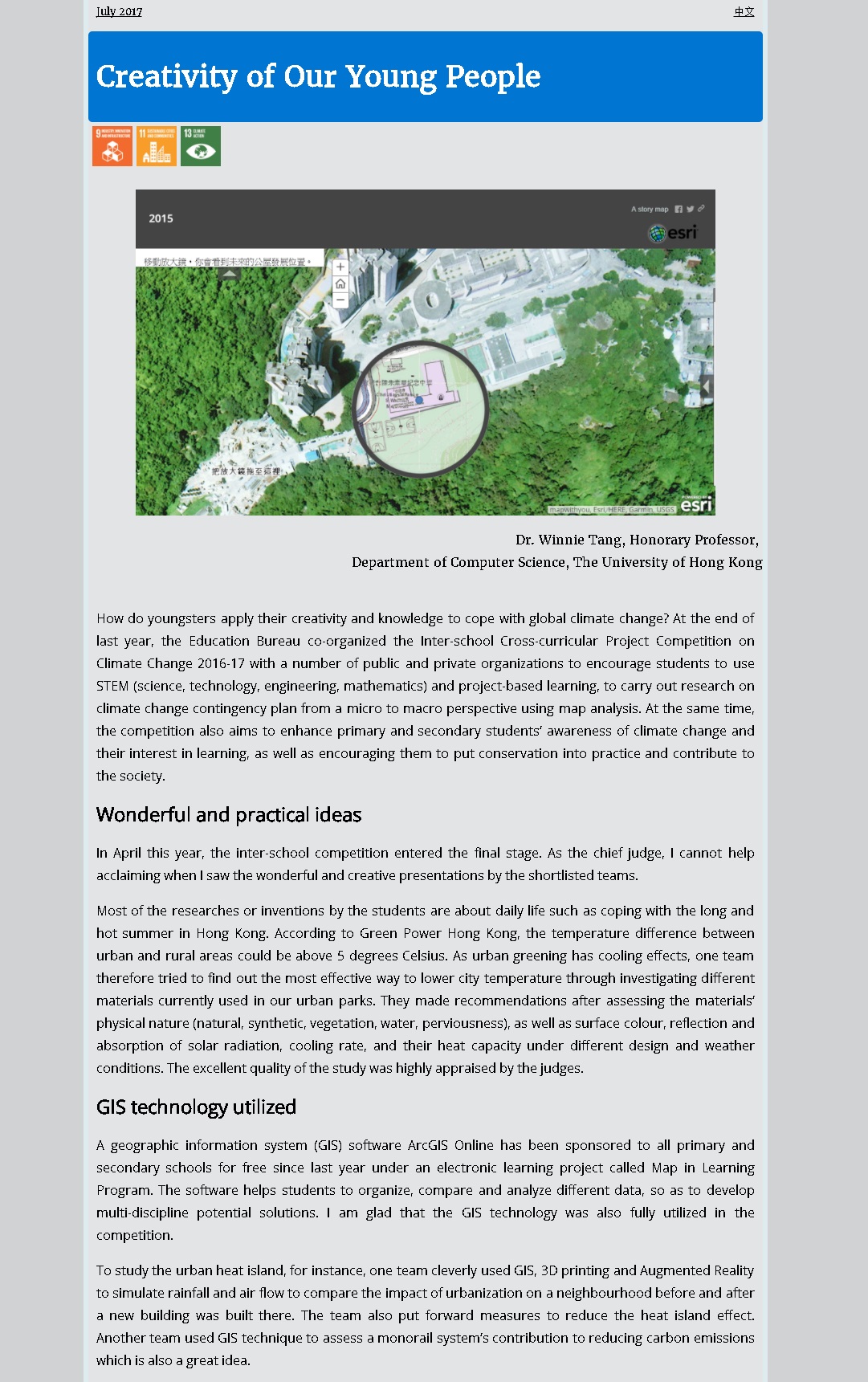網上版請按此

Creativity of Our Young People
How do youngsters apply their creativity and knowledge to cope with global climate change? At the end of last year, the Education Bureau co-organized the Inter-school Cross-curricular Project Competition on Climate Change 2016-17 with a number of public and private organizations to encourage students to use STEM (science, technology, engineering, mathematics) and project-based learning, to carry out research on climate change contingency plan from a micro to macro perspective using map analysis. At the same time, the competition also aims to enhance primary and secondary students’ awareness of climate change and their interest in learning, as well as encouraging them to put conservation into practice and contribute to the society.
Wonderful and practical ideas
In April this year, the inter-school competition entered the final stage. As the chief judge, I cannot help acclaiming when I saw the wonderful and creative presentations by the shortlisted teams.
Most of the researches or inventions by the students are about daily life such as coping with the long and hot summer in Hong Kong. According to Green Power Hong Kong, the temperature difference between urban and rural areas could be above 5 degrees Celsius. As urban greening has cooling effects, one team therefore tried to find out the most effective way to lower city temperature through investigating different materials currently used in our urban parks. They made recommendations after assessing the materials’ physical nature (natural, synthetic, vegetation, water, perviousness), as well as surface colour, reflection and absorption of solar radiation, cooling rate, and their heat capacity under different design and weather conditions. The excellent quality of the study was highly appraised by the judges.
GIS technology utilized
A geographic information system (GIS) software ArcGIS Online has been sponsored to all primary and secondary schools for free since last year under an electronic learning project called Map in Learning Program. The software helps students to organize, compare and analyze different data, so as to develop multi-discipline potential solutions. I am glad that the GIS technology was also fully utilized in the competition.
To study the urban heat island, for instance, one team cleverly used GIS, 3D printing and Augmented Reality to simulate rainfall and air flow to compare the impact of urbanization on a neighbourhood before and after a new building was built there. The team also put forward measures to reduce the heat island effect. Another team used GIS technique to assess a monorail system's contribution to reducing carbon emissions which is also a great idea.
Eating Locally reduces carbon emissions
As we all know, animal husbandry is the main cause of greenhouse gas emissions, thus, the students wanted to promote vegetarian diet. They quoted a foreign research that Hong Kong's annual carbon emissions of 5.5 tons per capita per year was due to meat consumption, while vegetarian diet could reduce carbon emissions by 1.5 metric tons per capita per year. The students tried to tackle the problem from different perspectives, including study on whether secondary schools and universities had been supplying vegetarian food, and researched on the number of vegetarian restaurants in different districts versus their demographic characteristics. They also carried out experiments to find out whether vegetarian diet could really reduce carbon emissions. It is quite comprehensive.
If you do not want to be a vegetarian, but still want to contribute to the health of the earth, you can use the mobile application (app) developed by another group of students. The app simply calculates the "food mileage", that is, "the transport distance from food production through delivery to consumers". In Hong Kong, a lot of foods are imported from overseas, such as beef from the United States, mushroom from Malaysia, cabbage from Ningxia, etc. The transportation of these uses up a lot of fuel. The students referred to an estimate that the transportation and processing of every 10 liters of orange juice would use up 1 liter of diesel oil. They wanted to promote “Eating Locally and Seasonally” through game and mobile app. Based on their formula, imported beef from Japan, for example, was found to produce more carbon emissions than those from the Mainland by up to 130 times.
Every penny counts
One of the hot topics is global population expansion which will trigger another energy crisis sooner or later. Some students thought of setting up a power generator at home to generate electricity by tap water and sewage. The design is to install a power generator near the faucet and in the water pipes, the flowing water will push the power generator, thereby, generating electricity. The students further estimated the effect and benefits if every flat of a public housing estate was equipped with such power generator. Although the cost and benefit may not be proportional, the idea is gratifying.
Every penny counts - many energy-saving magic can also be realized by the smallest details in our daily living. For example, by using a magnetic control power plug, air-conditioning and lighting will be automatically switched off when the door is locked; the green air-conditioned window disconnects the air-conditioner when the window is opened. This is an idea from another primary school.
Other inventions, such as seaweed street lights and green power generating bicycle, etc. are also very creative. If we put in more resources for them to further develop the ideas, some of the designs could bear fruit in terms of feasibility and practicality.
I am unable to cover all the wonderful ideas and inventions here. I would like to congratulate the winning teams once more, and I also hope that the students could pay attention to their surroundings and their society while broadening their horizon through information research. By doing so, they can have more in-depth understanding of a problem. I hope they would continue to improve the society for the benefit of mankind through innovations and creativity.
Dr. Winnie Tang, Honorary Professor,
Department of Computer Science, The University of Hong Kong